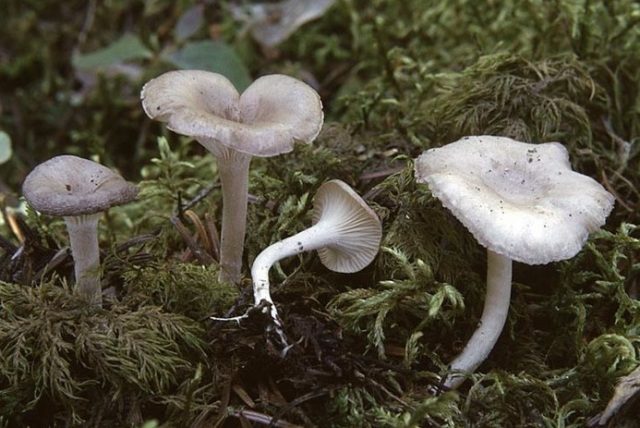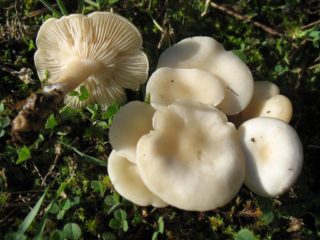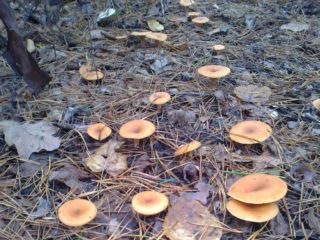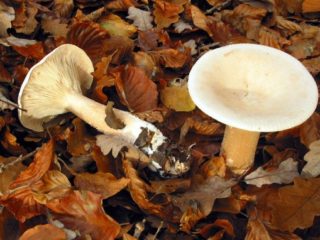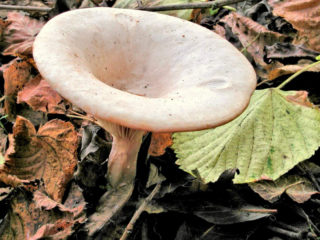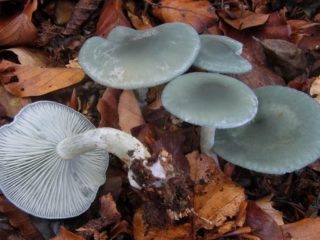Content
Snow talker is an edible spring mushroom. Fans of “quiet hunting” rarely put it in their basket because they are afraid of confusing it with toadstools. Indeed, the snow talker has similar poisonous counterparts, which should be distinguished by appearance.
Where do snow talkers grow?
Snow talker (lat. Clitocybe pruinosa) is a rare edible mushroom that is collected in the spring. It appears in light-colored coniferous forests in early May; the collection season lasts only a month, until the beginning of summer.
What do snow talkers look like?
This is a small mushroom with a rounded cap, the diameter of which in mature specimens does not exceed 4 cm. The color of the cap is gray-brownish with a dark center, its surface is shiny, waxy in dry weather.
In young representatives of the species, the cap has a rounded-convex shape; with age it becomes prostrate, with a depressed middle. The frequent plates descending to the stem are yellowish in mature specimens, and whitish in young ones.
The leg is small and thin - no more than 4 cm in length and 3 mm in thickness. It is straight or curved and has the shape of a cylinder. It has a dense structure and a smooth surface, the color is reddish-cream, matching the color of the plates. The dense pulp does not have a distinct odor or emits a faint earthy aroma.
Is it possible to eat snow talkers?
Snow talkers are classified as conditionally edible mushrooms; they must undergo heat treatment before consumption. But finding them in the forest is quite difficult, and inexperienced mushroom pickers can easily confuse them with their poisonous counterparts.
Taste qualities of the snow govorushka mushroom
The taste of these mushrooms is not particularly refined, but quite worthy for a spring delicacy. Light mealy notes are felt, and a pleasant mushroom aroma remains after cooking.
Benefits and harm to the body
Edible snow talkers have many beneficial properties. They contain valuable mineral salts, rare for plant products, and vitamins. Possessing low calorie content, they are a source of fairly high-quality protein. Mushroom dishes are harmful for children under 10 years of age and people with gastrointestinal diseases.
False doubles
The translucent talker is similar in appearance and size to the snow talker - an inedible, poisonous mushroom from the Rowadovaceae family.
The fruiting season also begins in May, but it is longer - until September.
The snow talker has another poisonous counterpart - the reddish talker, which contains muscarine. It grows in the same places as edible mushrooms and is similar in appearance and size. Fruiting of the toadstool begins in June - this is the main difference. When young, its cap is grayish-white in color; in older specimens it acquires brown tones.
Collection rules
Snow talkers are collected in May. The fruiting season sets it apart from other inedible or poisonous varieties that begin to appear in the summer and grow until late autumn.
During collection, mushrooms are twisted out of the ground by hand. They take young, strong specimens. Old ones lose their pleasant taste and beneficial qualities. The fibrous legs are cut off; they are of little use for food. Do not put suspicious or heavily worm-eaten fruiting bodies in the basket.
Use
Mostly young specimens with elastic flesh and light-colored plates are eaten. The legs have no taste, so mostly the caps are used in dishes; they are fried, boiled, salted and pickled. When fresh, they are not suitable for food, as they contain bitter enzymes.
You can cook delicious mushroom soup from snow talkers. To do this, they are washed, set to boil, and filled with cold water. Peel potatoes for soup, chop carrots and parsley root. 10 minutes after the water boils, remove the foam and add chopped potatoes to the pan.Parsley root, tomato and carrots are fried in vegetable oil, salt and pepper, and added to the soup 5-6 minutes after the potatoes. After 5 minutes, add chopped green onions, add salt if necessary, and turn off the heat.
For the soup recipe you will need: 500 g talkers, 200 g potatoes, 1 carrot, 1 tomato, 2 parsley roots, 1 small bunch of green onions, 50 ml vegetable oil, salt, pepper, bay leaf, spices to taste.
Conclusion
The snow talker is suitable for preparing culinary mushroom dishes, pickles and marinades. It is easily confused with the translucent talker, which also grows in the spring and is poisonous. If you have the slightest doubt about identifying a mushroom, you should leave it to grow in the forest. And experienced lovers of “silent hunting” will be able to prepare delicious dishes from the first spring mushrooms in May.
